Nate Fleming's Blog, page 45
March 24, 2014
What’s Wrong With Christian Filmmaking?
This morning I read a review of the film God’s Not Dead over at Gospelspam.com, and was struck by the thesis of the review, which is found in the title, “God’s Not Dead but Christian Screenwriting Is.”
The review had plenty of good to say about the film, but also plenty to say about the problems currently found in Christian filmmaking – specifically the writing. This issue brings up strong feelings and thoughts in me, as I am a Christian, and I have been a student of screenwriting since 2007. I’ve written screenplays (both produced and un-produced), and have recently published my first novel, Thimblerig’s Ark. I felt led to respond to the article in the comment section at Gospelspam, and then decided to reproduce the bulk of my comments here.
Let me say from the start that my intention with this article is not to attack my fellow Christian artists. I generally have great respect for anyone who carries an idea from imagination to the screen, and with Christian artists, I also respect the intention behind the process. And I know that there are probably some very good independently made Christian films that try like crazy to break out to a larger audience, but are unable to do so for many different reasons. The intent of this article is more to express my frustration of the limitations faced by Christian artists, put there by the church at large.
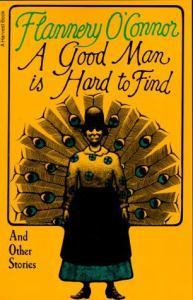 For centuries the church was the main sponsor of amazing art. Christians were responsible for setting the tone of art for the culture, and we have the amazing work of artists such as Bach, Handel, Mozart, Rembrandt, Michelangelo, and many others as the fruit of that labor. But for some reason Christians have rarely been able to accomplish dramatic storytelling effectively on any large scale, which is ironic, considering that we are the custodians of the Greatest Story Ever Told. While there are the occasional mold-breakers (thinking about C.S. Lewis and Flannery O’Connor in the literary world, to name a couple), modern Christians seem to have a hard time jumping feet-first into the story-telling deep end, telling a compelling story that will go beyond the church walls.
For centuries the church was the main sponsor of amazing art. Christians were responsible for setting the tone of art for the culture, and we have the amazing work of artists such as Bach, Handel, Mozart, Rembrandt, Michelangelo, and many others as the fruit of that labor. But for some reason Christians have rarely been able to accomplish dramatic storytelling effectively on any large scale, which is ironic, considering that we are the custodians of the Greatest Story Ever Told. While there are the occasional mold-breakers (thinking about C.S. Lewis and Flannery O’Connor in the literary world, to name a couple), modern Christians seem to have a hard time jumping feet-first into the story-telling deep end, telling a compelling story that will go beyond the church walls.
This is a multi-layered conversation, and it is thankfully a conversation that is taking place among many creative Christian writers and artists. In 2007 I was privileged to take a month long intensive screenwriting course in Hollywood with Act One, an organization that trains Christian writers and producers how to write and produce good films with integrity. It was one of the most stimulating months of my life, as we wrestled with these issues on a daily basis. From that time, and since, I’ve thought of three major hurdles that Christian artists face when attempting to write, sing, or film something that will have the potential to impact the world. For the sake of this article, I will focus on Christian filmmaking.
The first problem is that Christian filmmaking needs to be SAFE. When is the last time a big “faith-based” film had an R rating because of it’s true depiction of sin? It’s a huge dilemma, because we – as followers of Christ – don’t want to sin ourselves in making a film, or encourage sin, but this really handcuffs us and our ability to realistically portray life. If you are a Christian, when was the last time you saw a Christian film that truly challenged your faith? What was the last Christian film that asked questions without giving answers? Does the greater Christian culture allow for that?
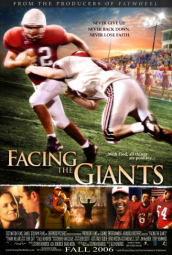 The second problem is that Christian filmmaking needs to be PREDICTABLE. When I was doing drama in summer camps in Kazakhstan, a friend pointed out that the representation of Satan was always more interesting than the representation of Jesus. He also said that it wasn’t saying much, because Satan was fundamentally not so interesting because no matter the drama presentation, he always acted the same way, and the same was true of Jesus. I see this carried through in expectations for Christian filmmaking – the protagonist and the antagonist usually act a certain way, and if they don’t, the film won’t be received well. What does the audience want? The non-Christian needs to become a Christian, and the Christian needs to find “victory” of some sort. My major disappointment with the Kendrick brother’s film, “Facing the Giants”, was that it was a wonderful opportunity to show how a Christian deals with failure, but in the end the filmmakers decided to make it a fairy tale where a prayer changes the direction of the wind. It was predictable, and the film was wildly successful.
The second problem is that Christian filmmaking needs to be PREDICTABLE. When I was doing drama in summer camps in Kazakhstan, a friend pointed out that the representation of Satan was always more interesting than the representation of Jesus. He also said that it wasn’t saying much, because Satan was fundamentally not so interesting because no matter the drama presentation, he always acted the same way, and the same was true of Jesus. I see this carried through in expectations for Christian filmmaking – the protagonist and the antagonist usually act a certain way, and if they don’t, the film won’t be received well. What does the audience want? The non-Christian needs to become a Christian, and the Christian needs to find “victory” of some sort. My major disappointment with the Kendrick brother’s film, “Facing the Giants”, was that it was a wonderful opportunity to show how a Christian deals with failure, but in the end the filmmakers decided to make it a fairy tale where a prayer changes the direction of the wind. It was predictable, and the film was wildly successful.
The third problem is that Christian filmmaking needs to PREACH TO THE CHOIR. With the exception of Gibson’s Passion of the Christ, how many films made by Christian filmmakers have made any sort of dent in the culture beyond the church walls? When is the last time a film made by Christians received substantial praise from non-Christian film reviewers? This past weekend, God’s Not Dead had good box office – earning a respectable $9.2 million, but how much of that cash was from non-Christian wallets? The film also currently has a 40% on Rotten Tomatoes, which is high for the typical Christian-made film.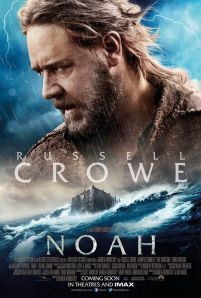
Darren Aronofsky’s upcoming film, Noah, is a very interesting case to me, and it is a movie I’ve been looking forward to for some time. Unfortunately, a big reason that I’m hopeful for the film is that it was NOT made explicitly by Christians, and while the studio also wants a piece of the “faith-based audience box office pie”, Aronofsky made the film he wanted to make. I am much more interested in this film than I am in God’s Not Dead or the recent Son of God, because it will be everything a typical Christian film is not: it will be a dangerous film – forcing the viewer to rethink the traditional way of viewing the story of Noah; it will undoubtedly be unpredictable, because Aronofsky is not handcuffed by an allegiance to modern evangelical sensibilities; and finally, thousands and thousands of people are going to be flocking to see it, and not because of their church allegiance.
How cool would it be if a film made by Christians could make the box office that Noah will make, with audiences from every different walk of life? Here are my tips on how the body of Christ can come closer to making that happen:
1) We need to permit our artists (writers, actors, musicians, filmmakers) to take more risks. And artists, whether you are permitted or not, take more risks. Did you really get into your artistic field because you liked playing it safe? Why play it safe with the most important thing you have to say?
2) We need to encourage our artists to challenge rather than stroke our sensibilities. A pearl is made when dirt is irritated inside the oyster, after all. And so artists, don’t wait for permission. Start challenging your audience. They will undoubtedly resist you, but we need to be challenged or we’ll stagnate and fade away into irrelevance.
3) We need to recognize that art is art, the pulpit is the pulpit, and while the two might cross paths from time to time, they are completely different animals. This goes for everyone. Does everyone truly understand this? With all the recent criticisms of Noah because it “is unbiblical”, I have to think that lots of people don’t.
4) We need to be okay with movies that don’t give all the answers. If they succeed in asking some good, deep questions, they might actually open the doors to conversations where answers can be explored. Artists, isn’t part of our job to provoke questions? Don’t feel you have to end every sentence with a period
5) And most importantly: tell good stories. As Frank Capra famously said, “If you want to send a message, try Western Union.” If you are an artist, the quality of your work should be at the top of your list of considerations. Jesus wasn’t known for telling mediocre stories that ticked off all the correct religious boxes. He was known for telling compelling stories that challenged his listeners while communicating God’s truth. Aren’t we supposed to be like Jesus?
I need to conclude this article by saying once more that I do respect that there are Christians out there trying to bust into the filmmaking business, and I wish them well. I just hope we can figure out how to tell The Story – truly the Greatest Story Ever Told – in the manner in which it deserves, and in such an excellent way that people outside the Christian subculture will receive it.


March 23, 2014
Free March 28!
To celebrate the release of Darren Aronofsky’s film, Noah, we will be offering a special one day free download of Thimblerig’s Ark. March 28, 2014 from 12:01 AM PST.
Click here to reach Amazon’s Thimblerig’s Ark page.
Please help spread the word!


March 22, 2014
You Know About Noah, But Have You Heard The Animal’s Story?
3/20/14
By Nate Fleming
—
Nate Fleming’s debut novel Thimblerig’s Ark is a middle grade novel inspired by the writings of C.S. Lewis, the book of Genesis, and an Irish pub song about why the unicorn missed out on Noah’s Ark. During its two free promotional days on Amazon in March, Thimblerig’s Ark reached the top ten of free Kindle books in the Children’s Fantasy and Magic genre, and the top thirty in the Children’s Literature & Fiction genre.
—
Nathan Fleming still remembers the day the idea for Thimblerig’s Ark came to him. He was sitting in Tommy Condon’s Irish Restaurant in Charleston, South Carolina, when the band started singing a song about the unicorns missing out on Noah’s Ark because of their foolishness. “I had a hard time reconciling this idea of unicorns getting left off the ark because they were acting too silly to be bothered,” Fleming explains. “I’d always imagined unicorns to be noble and somewhat dangerous. Then the idea came to me that I could try and tell a more serious version of the animal’s story.”
Fleming began the novel in 1999 when he moved to his wife’s native country of Kazakhstan. Over the next several years, he’d work on the story when he had the time, also being busy founding and directing the Kazakhstan English Language Theater, the first English language theater in Central Asia. As the story went through various incarnations, the characters and situations changed, but the unicorns remained the anchor to the tale.
Most surprising to Fleming was the hero, who turned out to be extremely unlikely – a con-artist groundhog named Thimblerig. In the novel, the groundhog is not only in danger of being washed away by the flood, but he’s also in danger of losing his soul because of his lack of concern for the animals of the forest. “The story is really Thimblerig’s story,” Fleming says. “He starts out trying to run the ultimate con on the forest’s suckers, but he is finally confronted by how destructive his own selfishness can be, and he’s forced to change or lose it all.”
The decision to complete the story came fifteen years later when Fleming and his wife, Koolyash, found out they were pregnant with their third child. “I’d been trying to write the story for so long, and realized that it was easier to start something it than to finish it. When we found out we would be having another child, I was convicted to complete it so that my children would have something that they could one day read to their own children.” Fleming set the goal to finish the novel by the time the new baby was born, and when baby Noah came into the world, the manuscript was complete.
Fleming currently lives in Chengdu, China, with his wife and three children. Besides being a writer, he also works at an international school where he teaches reading, language arts, and drama. “Living overseas for fifteen years has given me a unique perspective on the world, and, I hope, the experience makes my writing more accessible to readers from all over the world.”
Nate Fleming’s middle grade fantasy, Thimblerig’s Ark, is available exclusively for Amazon’s Kindle.


March 21, 2014
Noah Review Asks: What About the Animals?
I started out to write a blog entry chronicling the reviews that are starting to come in for Darren Aronofsky’s Noah, and had already linked to one particular review and pulled out some good quotes, when I came to the review from The Hollywood Reporter, and everything I was doing came to a grinding halt. In the (mostly positive) review, film critic Todd McCarthy says:
If anything, the animals get short shrift here. Noah never has to go out and gather them; hundreds of them just show up, as if they’d experienced the same vision as Noah’s (ed: read Thimblerig’s Ark!), push aboard the waiting ark and promptly go to sleep, not to reawaken or be seen again until the voyage is done. This not only comes off as something of a cheat — after all, it’s always interesting and fun to examine the occupants of the world’s first and most famous temporary zoo (ed: read Thimblerig’s Ark!), especially given some of the fanciful and/or extinct critters the filmmakers ever-so-briefly put on show here — but it’s also a convenient way to avoid the dilemma of explaining how the animals got along so well for the duration without eating each other (ed: read Thimblerig’s Ark!).
***Note that the parts in parenthesis and the italics for emphasis were obviously added by the author of this blog.***
I want to focus on the three highlighted statements:
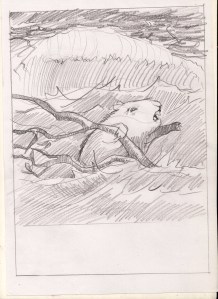
Thimblerig’s vision of a world-ending flood, the flood of Noah.
1) The animals in Aronofsky’s film just show up as if they’d had Noah’s vision. We’ve known since the trailers started rolling out that Noah receives his knowledge of the impending flood by way of a vision from God. In Thimblerig’s Ark, the groundhog Thimblerig has similar visions, but it’s not surprising that both stories would share this idea. Dreams and visions are a common enough trope in stories as a way for the divine to communicate with the worldly. It’s just very interesting that Mr. McCarthy picked up on it with reference to the animals, and mentioned it in his review. (Read Thimblerig’s Ark!)
2) Mr. McCarthy says that it’s always interesting to look at the animals in “the world’s first and most famous temporary zoo”. I read that statement and felt rather giddy, because that is exactly what Thimblerig’s Ark does! The story doesn’t bother so much about what they are (green alligators, long-necked geese) as much as in who they were. They are fully-realized characters who struggle with their situation as much as any human character would. (Read Thimblerig’s Ark!)
3) In the review, Mr. McCarthy says that Aronofsky has the animals show up and promptly fall asleep, side-stepping any attempt to explain how the animals got along in the ark during the voyage. Thimblerig’s Ark asks this same question, and not only doesn’t side-step it, but jumps straight in feet first and answers both the why and how of it. (…you know what I’m going to say…)
This excites me, because I’ve thought for a long time now that my novel could be a quietly good supporting novel to this huge epic film, and this review confirms it (I wonder if Mr. Aronofsky would be interested in writing a forward? Maybe I should send him a request). And I hope that if you have actually cared enough about this subject to read this far down, that you will help in my grass roots efforts to get the word out. Here are two big ways you can help:
1) Download Thimblerig’s Ark from Amazon! This may be the obvious one, but it needs to be mentioned. Download it, and then read the book, and then go and make a review on Amazon.
2) Share the download link with your friends on Facebook, Twitter, Goodreads, wherever you like to lurk. Encourage them to run, not walk, and download the book!
Thanks to anyone who will do this! I sincerely hope that you enjoy the story, and that it increases your enjoyment of the film (if you go see it), and helps deepen your thoughts on the story of Noah’s Ark in general.


March 18, 2014
Climbing The Tree
When I was a kid, we had this big oak tree in our front yard that my brother and I would climb. I spent hours up in that big tree, and I loved everything about it – the earthly smell of the leaves, the rough feel of the bark, the wind rustling the branches – it was a place of refuge from the problems of my 1980′s adolescent world – such as which parachute pants I should wear, or which air guitar move I’d make at the sock hop, or how I could approach that girl I secretly liked. They may not seem like big problems now, but at the time, they were huge. Up in the tree, they didn’t concern me.
There was a certain place in the tree where a big branch split off into a Y shape, and it made a perfect place to sit. It was about as high up as I would dare to go, because at that point the branches started to get smaller as top of the trunk of the tree ended. 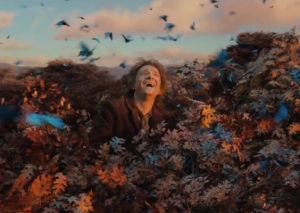 I would stare up at the small branches and leaves above, wishing that I could make it all the way to the top and poke my head out of the top of the tree like Bilbo in the forest of Mirkwood. I was certain that the air was fresher up there, that the view would be the most fantastic view around (even though it was about on the same level as the view from the window of my second floor bedroom), and that it might even be a thin place where God would give me the special epiphany I needed to solve all my problems.
I would stare up at the small branches and leaves above, wishing that I could make it all the way to the top and poke my head out of the top of the tree like Bilbo in the forest of Mirkwood. I was certain that the air was fresher up there, that the view would be the most fantastic view around (even though it was about on the same level as the view from the window of my second floor bedroom), and that it might even be a thin place where God would give me the special epiphany I needed to solve all my problems.
It was a magical place, and now that I’m an adult, I find that I long for the magic of it.
–
The decision to self-publish my book, Thimblerig’s Ark, on Amazon put me right back up in that tree.
What does that mean? It means that I’m proud that I finally finished the story that I started fourteen years ago. It was a struggle, sort of like getting started up the tree, where once I cleared that first hurtle of the lowest hanging branch, I felt free to continue climbing. I’d go up and up, climbing like a squirrel. It was the same with the book; once I got past the halfway point of the first draft, I took off and wrote and wrote. Like a squirrel. But one who knows how to use a laptop and can write quickly.
There were some difficult sections, like the branches that seem just a bit too high, but I forced myself to continue. Sometimes it was exhilarating, reminding me of the times I would grab a branch that was not as sturdy as I thought, and I’d slip off. The first time I gave my manuscript to a group of friends to read was such a moment. As I waited for them to finish my draft, my heart was in a constant state of beating faster.
And then, when I pressed “Submit” to upload the book onto Amazon, I felt it again. Sending Thimblerig’s Ark whizzing across China, past schools of tuna in the Pacific Ocean, to the Amazon servers in California, it dawned on me that now my soul was opened up for anyone to see. That seems a bit drastic to say, but it feels true. I’d invested so much of myself into this story that knowing others would be reading it brought on intense feelings of vulnerability. Once the free downloads started moving this past weekend, and the numbers started growing as friends and family spread the word, it struck me that all kinds of people were now going to be reading what I wrote. And once more I was up in the tree, heading for the open breezes of the top leaves, and it felt exhilarating and terrifying all the same time.
In self-publishing, the treetops are exclusive and elusive, and the promises they hold are almost mythical to those of us who have not arrived. What’s up there? All I have to go on is what I’ve heard whispered in the company of other authors seeking to finish the climb.
“The winds of success blow up there,” they say. I try to imagine what those winds feel like, and I find it extremely difficult, but they must feel refreshing, right? They also say that the view from up top is unbeatable, making all the risks of the climb worthwhile.
Meanwhile, I’m down here, in the middle of the thick branches, gazing up and seeing glimpses of light through leaves overhead, wondering if I’ll ever get up there.
 But the thought occurs to me: will it really be better up there? After all, this place where I find myself now, in the middle of the tree, has never failed me before. This is where I worked out the problems of getting my story’s hero from inciting incident to resolution. This is where I was struck by such inspiration, that it seemed be coming from somewhere outside of myself. This is the place where I accomplished my goal of writing and completing a novel, a novel that my eleven year old daughter was reading last night, and discussing the characters with me, asking me questions, and ending the conversation with “I love it, Daddy!”
But the thought occurs to me: will it really be better up there? After all, this place where I find myself now, in the middle of the tree, has never failed me before. This is where I worked out the problems of getting my story’s hero from inciting incident to resolution. This is where I was struck by such inspiration, that it seemed be coming from somewhere outside of myself. This is the place where I accomplished my goal of writing and completing a novel, a novel that my eleven year old daughter was reading last night, and discussing the characters with me, asking me questions, and ending the conversation with “I love it, Daddy!”
I think that what I’m learning as I sit here in the tree, listening to the breezes blow through the branches, is that I need to be content where I am in the middle of the tree, but open to the possibility that I could move up to the treetops if the circumstances are right. I need to realize that the odds are against my reaching the top, but that anything is possible. I need to accept that if I reach the top without having learned contentment in the middle, it is doubtful I will be content at the top.
It’s perfectly fine (and maybe even necessary) to dream about getting up there, but it’s perfectly fine to be happy in the middle, too.
Both places are good. It’s up to me to enjoy being where I am.


March 16, 2014
Happy St. Paddy’s Day from Thimblerig’s Ark
In honor of St. Patrick’s Day, I thought it would be appropriate to post the song that sparked the idea for Thimblerig’s Ark, which is the story of Noah’s Ark from the animal’s point of view.
There was green alligators and long-necked geese
Some humpty backed camels and some chimpanzees
Some cats and rats and elephants, but sure as you’re born
The loveliest of all was the unicorn
The big difference is that in Thimblerig’s Ark, the unicorns are far from the silly foolish animals from the song.
The Unicorn was written by Shel Silverstein, and made into a popular song by the Irish Rovers.
Order Thimblerig’s Ark today on Amazon!
Beannachtaí na Féile Pádraig oraibh!


Taking a break from promoting my book…
…to post this picture, which is now officially my Favorite Picture.

Gandalf checking his email, or maybe playing Floppy Bird?


March 15, 2014
Thimblerig’s Ark is free for the next 48 hours!
What are you doing loitering around my blog? Hop over to Amazon and pick up your free download of Thimblerig’s Ark while you still can. It won’t be free forever!
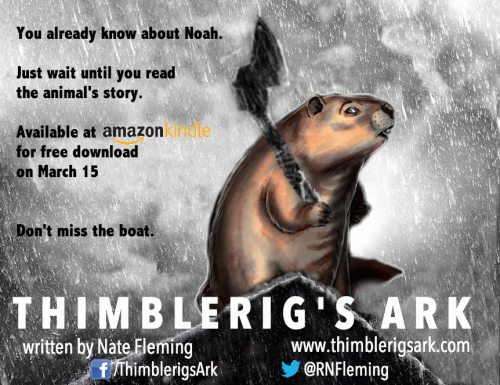
Download Thimblerig’s Ark for Free!


March 13, 2014
Thimblerig’s Ark Trailer
This weekend, Thimblerig’s Ark is Free!
To celebrate Thimblerig’s Ark being complete and available, this weekend you can download it for your Kindle device or application for free! Please help spread the word on this grassroots effort, and if you enjoy the book, please review it on Amazon!
Here’s the link to Thimblerig’s Ark on Amazon.
Also, if you don’t have a Kindle device, you can download the Kindle app for free for most devices. It’ll take you a bit of time, but it won’t cost you a penny!
Just go here to download the Kindle app!
And whether you know me or not, if you download the book, thanks for the support!







